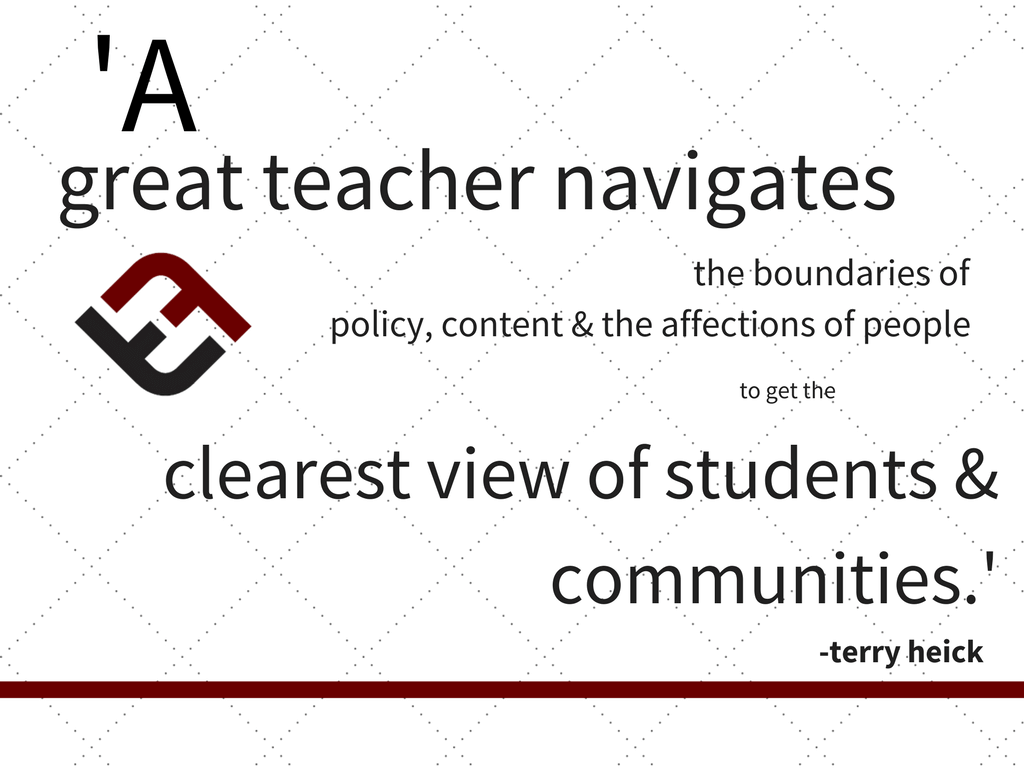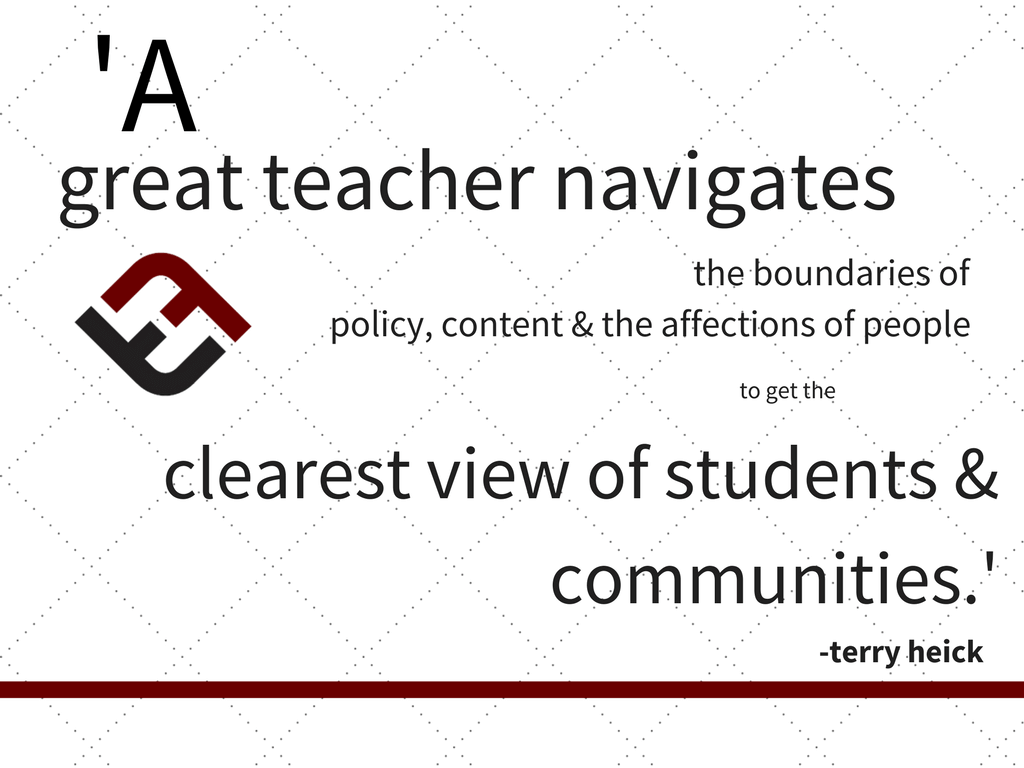
Are Schools Prepared For Great Teachers?
by Terry Heick
In On The Road, Jack Kerouac describes the ‘purity’ of movement–the juxtaposition of a singular here, and a plural everywhere that create a kind of serenity. This is a purity, and most notably an enthusiasm, that we can learn from as educators.
After decades of disagreement and perceived waywardness in education, recent efforts in school improvement have focused less on movement and more on standardization (a sibling of industrialization, but not necessarily a twin). Among the tactics at use here is a “guaranteed and viable curriculum, which has been recognized not just as crucial to progress, but the most crucial, with Robert Marzano calling it “the first factor, having the most impact on student achievement” among all other improvement strategies in his oft-quoted What Works in Schools.
Richard DuFour, Mike Schmoker, and other professional development leaders consistently call on schools to start with this idea as a bedrock for further efforts. What is the definition of a guaranteed and viable curriculum? Marzano explains.
“There is a significant amount of research that providing students with access to a guaranteed and viable curriculum has a significant, positive impact on student achievement. Guaranteed means that all students will be taught the same skills and concepts regardless of the teacher to whom they have been assigned. Viable means that the curriculum can be taught in the amount of time a teacher has to teach. If a district is to provide students with a guaranteed and viable curriculum, it is perfectly reasonable that it establish parameters for common pacing.”
Among other ideas, the words same, skills, concepts, taught, common, and pacing stand out to give us a sketch of what’s at work here. If our effort is to improve the school and the learning within it, it makes sense for teachers to pool their collective wisdom and might to make it happen. If you want to go fast, go alone; if you want to go far, go together.
But in the process, we might be losing the purity of brilliance. Of what makes great teachers great.
Scale As Proof Of Quality
One of the hallmarks of an idea’s success is it’s endurance. In any profession, people strive to create an idea that stands out from the rest, in hopes that it eventually becomes adopted by the crowd, the idea disappearing again into anonymity because it’s everywhere.
This ironic pattern of expression is one of the great burdens of identity, and it’s no less egregious or sarcastic in schools, where we create mission statements promising to teach students to think for themselves—to create, design, and collaborate—in awkward pursuit of the mastery of admittedly academic content.
Stand out while fitting in. Be the best, but take everyone with you.
If we consider greatness—as cliché an idea as it seems—in terms of events and ideas, we can see part of the problem. Kerouac’s On The Road, Einstein’s Theory of Relativity, Dali’s surrealism, Martin Luther King Jr’s strength, Merton’s reflections, Flannery O’Connor’s sense of place, Ghandi’s wisdom, Muhammad Ali’s defiance, and other uber-human expressions were all jarring. They fractured accepted thinking. They humiliated their relative cultural circumstance in a way that didn’t just stand out or “shakes things up,” but made it seem impossible to return to previous thinking patterns.
There’s a conflict with greatness in education. It makes a mess.
When Teachers Disrupt
In On The Road, Kerouac writes “…we were all getting ready for the purity of the road…the purity of moving and getting somewhere…” Anywhere’s better than here. There is a gleam to change; movement manufactures possibility.
But the change can overwhelm the destination. Just as a great teaching tool, literacy strategy, curriculum framework, etc., is one often characterized by its ability to distinguish itself, be replicated, and last, the same goes for great teachers. Why? Schools, as they exist today, fueled by scale, transparency, and sustainability. All on board to make sense of this good idea, and then smear it all over the walls of the school.
In this circumstance, an idea can’t be great without the ability to scale, to be seen through, and to endure for everyone in every circumstance. This is a factor of standardization.
When we ask for great teachers, then, it’s not clear if we all mean the same thing when we use the term. What’s a great teacher? If nothing else, by definition a great teacher is going to be exceptional. Different. If everyone is extraordinary, no one’s extraordinary.
A great teacher navigates the boundaries of policy, content, and the affections of people and communities to get the clearest view of students. The most important gift a teacher has is the ability to see children for who they are, who they can be, and the relationship between the two. They have the unique ability to see students and content and thought and ideas and then nothing else—a blindness to irrelevance that lets the rest of the world melt away. They see your literacy plan, and your assessment policy, and your hashtag, and your app—but they see it within a macro context that it doesn’t matter—and can’t survive–without.
This means that they might not ‘buy-in’ to the new district initiatives. They may question the Chromebook ‘rollout.’ They might resist the testing if all of the data is just going to sit there without substantively altering future curriculum and instruction. They may not be the stars of the PLC.
And unless they have enough charisma to pull it all off, it’s all going to cost them their ‘team-player’ reputation. (Not fitting in is the first step to industrial obsolescence.)
This isn’t to suggest that a great teacher necessarily has to be a disruptive teacher. Nor that questioning the status quo makes you some sort of pedagogical martyr. You can check every box and smile every smile and integrate every bit of the district’s push and still be great. Some schools are designed to foster spectacular teaching and learning. Here, great teachers probably don’t seem the least bit disruptive. Instead, they energize its hallways.
But serving two masters is draining; so many strong teachers try for as long as they can to make it work, but ultimately, it just isn’t sustainable for too many of them. So they have to make a choice they shouldn’t have to make–students or policy. There is an inertia and strength and unpredictability to great teaching—a kind of informed and spectacular waywardness that may not waddle in the direction you point it. They fracture thinking and practice–not out of spite, but because they’re busy being great.
Teaching great means teaching differently--and that’s not easy. They often defy what you’re looking for because the standardization of education has you look for factors of standardization.
A fit.
A Common Language For Greatness
When you say ‘great teacher,’ you may be thinking ‘change lives,’ ‘reach students,’ and ‘teach thinking,’ but you may really mean “efficient actuator of district policy and non-negotiables, able to unpack standards and collect consistent data in order to inform precise and differentiated instruction of academic content in order to move students to proficiency.”
And that’s okay, as long as you and the teacher and parents and students are all clear in that definition. As they are, the same schools that seek guaranteed and viable and common and same as catalysts for excellence may not be ready for great teachers. Great teaching is disruptive teaching, and this is an uncomfortable idea schools aren’t always designed to allow for.
What might a school designed for great teaching look like? How can they attract, produce, and protect great teaching that helps the school, as a cultural institution, reach its goals?
How might that school’s curriculum, instruction, assessment, collaboration, professional development, and other drivers of ‘disruptive greatness’ be designed and integrated?
How can we honor the purity of pure pedagogy and knowledge-making as a process and endlessly human act? The most human of acts?
Which of our standardizations promote innovation and greatness, and which destroy them?
Are Schools Prepared For Great Teachers?

